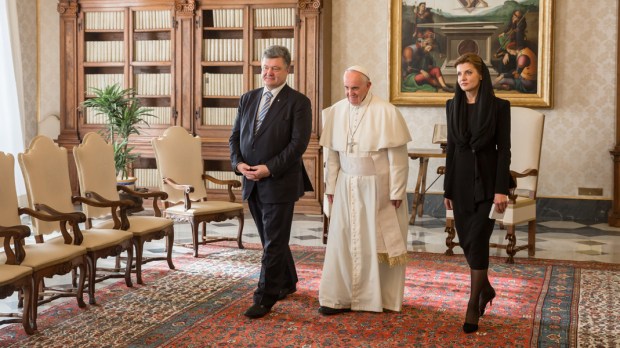Most people can only dream of an opportunity to meet the pope face to face, but if that dream ever does come true, here’s something to take into account: there’s a dress code.
The code applies especially to heads of state, and notes differences between formal state visits and informal encounters.
For women: Shoulders and the décolleté should be covered. Dresses and skirts should fall just below the knee. Shoes should be closed-toe. A black veil or mantilla is recommended. Jewelry should be discreet.
It’s recommended that women wear black, but there are a handful of women who have the “privilege du blanc,” that is, women who because of their role and status, are allowed to wear white.
This privilege is for queens of Catholic countries, or in some cases, the wife of the head of state of a Catholic country.
Vatican protocol has in recent decades somewhat relaxed for men. Previously, a coat with tails was expected, but in recent years, any dark-colored suit coat and a sober-colored tie has come to be acceptable.
It is also acceptable to meet the pope wearing traditional dress from the visitor’s native land.
Before speaking to the pope, one should bow, receiving his hand so that his ring, symbol of his authority as Successor of Peter, can be kissed. Non-believers, in lieu of kissing his ring, can show him the respect given to any head of state, shaking his hand. He shouldn’t be greeted with a kiss to the cheek, even if that is the customary greetings of the native land of the visitor (or the pope!).
The pope should be addressed as Your Holiness.
It’s also helpful to know how to correctly address others who might accompany the pope.
Cardinals are distinguished by their red zucchetto (the skull cap) and should be addressed as Your Eminence. Cardinals who accompany the pope, according to protocol, will be positioned with the longest-serving cardinals closest to the Holy Father.
Bishops, for their part, are addressed as Your Excellency.
Naturally, these codes and protocol are subject to change with the times, or even with the personalities of those on the Throne of Peter.
Pope Francis, for example, is accustomed to using black shoes, and is known to give a hearty handshake, instead of extending his hand for the customary ring-kiss. As a good Argentinean, he is also accustomed to greeting with a kiss, as we’ve often seen, especially when he meets with the elderly, the sick, or people close to him. He also often refers to himself in homilies or informal question-and-answer sessions as, simply, “Father” — just like any other priest.
The privilege du blanc is also more complicated in our day than it was in the past. Though originally intended as a show of gratitude for a country’s fidelity to the Church, today monarchies are little connected to religious confessions and plenty of rulers in traditionally Catholic countries are no longer Catholic.
So, yes, the rules can change. But the protocol and dress code is meant to be a sign of one’s manners, courtesy and respect — and all of that is linked to charity, which, like Christ, will never pass away.

